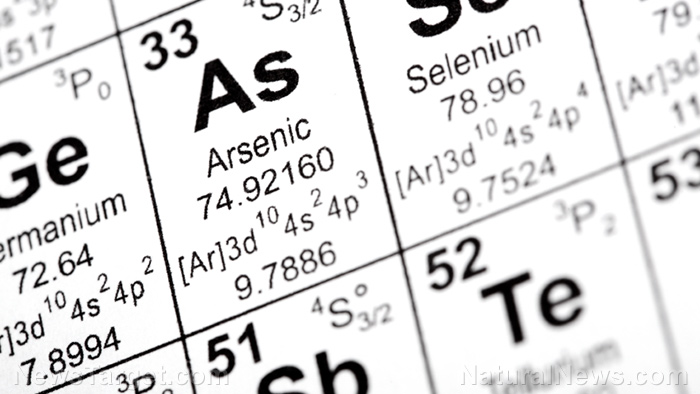Dinotefuran — toxicity, side effects, diseases and environmental impacts
12/05/2017 / By Janine Acero

Dinotefuran is a systemic insecticide of the neonicotinoid class, in the nitroguanidine sub-class. These include other chemicals like nithiazine, imidacloprid, thiacloprid, thiamethoxam, nitenpyram, accetamiprid and clothianidin.
Dinotefuran appears as white to off-white powder or crystals and is highly soluble in water. It is a neurotoxin that disrupts the insect’s nervous system function by inhibiting nicotinic acetylcholine receptors. It is used to control insect pests, such as whiteflies, thrips, leafhoppers, aphids, mealy bugs, stink bugs, leaf miners, ants, cockroaches, fleas, flies, crickets and gnats.
Dinotefuran is the common name for (EZ)-(RS)-1-methyl-2-nitro-3-(tetrahydro-3-furylmethyl)guanidine. It has a molecular formula of C7H14N4O3. It is under patent in many countries including Australia, China, EU, Indonesia, Japan, Switzerland, and the U.S.

List of known side effects
Dinotefuran is harmful if swallowed, as per the online chemistry database PubChem.
Mild to moderate poisoning can cause the following side effects:
- Nausea
- Vomiting
- Diarrhea
- Abdominal pain
- Dizziness
- Headache
- Mild sedation
Severe poisoning may cause agitation, seizures, metabolic acidosis, coma, hypothermia, pneumonitis, respiratory failure, hypotension, ventricular dysrhythmias, and death.
The United States Environmental Protection Agency (EPA) classified dinotefuran as “not likely to be a human carcinogen.”
Dinotefuran appears to have the potential to leach through soil and contaminate groundwater and drinking water.
Dinotefuran is nontoxic to birds, mammals, fish and algae, but it is highly toxic to marine/estuarine mysid shrimp. In addition, it is highly toxic to honey bees by all routes of administration.
Body systems affected by dinotefuran
Dinotefuran is classified as Category III, a moderate skin irritant and at least mild or moderate irritation could result from accidental eye exposure. Dinotefuran may also cause some neurotoxic, immunotoxic and reproductive effects.
Items that can contain dinotefuran
Dinotefuran is applied to a wide range of plants and crops such as cantaloupe, melons, watermelons, grapes, bell peppers, tomatoes, broccoli, cauliflower, celery, leaf lettuce, head lettuce, cabbage, Brussels sprouts, Chinese cabbage, bok choy, eggplants, cucumbers, summer squash, parsley, spinach and cotton. It also applied to greenhouse plants and flowers.
How to avoid dinotefuran
It is advisable to avoid products that use dinotefuran as an active ingredient, such as MTI-446, to prevent any form of contact or exposure. Handlers, mixers and applicators of dinotefuran may be exposed to its fumes in the workplace. The following are some preventive measures to avoid any contact with dinotefuran:
- Use this material only in well ventilated areas. Check with the workplace regulations on using respirators during handling of dinotefuran. In case of accidental aspiration, leave the area of contamination and go to an open area with fresh air or proper ventilation. Seek medical attention immediately.
- Avoid contact with skin or clothing. Wear a protective suit, chemical-resistant gloves and safety footwear or safety gumboots. Remove any contaminated clothing item carefully, avoiding any contact with the skin. Rinse the contaminated part of the skin with soap and water.
- Do not get this material in your eyes. Wearing goggles or a face shield is required before handling any chemical. In case of contact, remove contact lenses (if applicable), then rinse with running water for several minutes. Seek medical help at once.
- Do not eat, drink or smoke near this substance. In case of swallowing any amount of dinotefuran, give plenty of water to drink. Refer for medical attention immediately.
- Refer to the workplace regulations regarding proper handling of equipment before applying chemicals.
Where to learn more
- Systemic pesticides are penetrating deep into plants tissues, destroying beetles, trees, bees, and human hormones
- Colony Collapse Disorder Debunked: Pesticides Cause Bee Deaths
- Stink bug invasion strikes fruit, grain crops in North America
- Bed bugs now developing super resistance to pesticides, resulting in SUPER BED BUGS that just won’t die
- Huge pesticide manufacturer announces it will phase out bee-killing neonic chemicals by 2021… how many bees will still be left by then?
Summary
Dinotefuran is a systemic, neurotoxic insecticide.
Dinotefuran is used to control insect pests, such as whiteflies, thrips, leafhoppers and aphids, to name a few.
Dinotefuran is harmful when ingested, and is highly toxic to honey bees.
Sources include:
Tagged Under: Dinotefuran



















